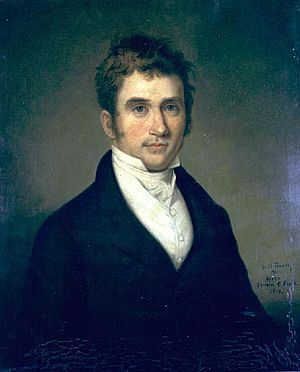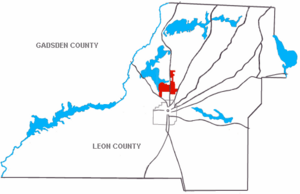Live Oak Plantation, Florida facts for kids
Live Oak Plantation was once a large farm in Leon County, Florida, where cotton was grown. It started as a smaller "forced-labor farm" of about 1,560 acres. John Branch established it in 1832. He lived there for 15 years while serving as the Governor of the Florida Territory.
Contents
Where Was Live Oak Plantation?
Live Oak Plantation was located in the north-central part of Leon County. It stretched from the eastern shore of Lake Jackson to the western edge of Lafayette Township.
Life on the Plantation in the 1860s
In 1860, records show that Live Oak Plantation was a busy place.
- About 820 acres of the land were used for farming.
- Another 260 acres were undeveloped.
- The plantation itself was valued at $4,000.
- The farm tools and machinery were worth $300.
- The farm animals were valued at $2,390.
- Sadly, 68 people were enslaved and forced to work on the plantation.
- The farm produced 2,000 bushels of corn.
- It also produced 73 bales of cotton.
Changes and New Owners (1870s-1900s)
After John Branch passed away, his family sold Live Oak Plantation. On June 9, 1870, it was sold to Howard S. Case from Pennsylvania. At this time, the plantation was about 1,250 acres. This sale was important because it was one of the last times a large plantation in Leon County was bought by someone from the northern states.
In 1887, the Case family sold the plantation to Edmund H. Ronalds. He was from Edinburgh, Scotland. Edmund would spend his winters at Live Oak. He married Lisa Williams in 1891. Lisa was the daughter of Joseph John Williams, who owned La Grange Plantation. Sadly, Lisa died in 1892 from tuberculosis while in Scotland. Edmund passed away in 1895.
After Edmund's death, Live Oak Plantation became even larger. Its boundaries now reached Lake Hall, Lake Overstreet, and Lake Elizabeth.
Edmund Ronalds' brother, Dr. Tennent Ronalds, became the new owner. Tennent had studied at the University of Edinburgh and the University of Bonn. Even though he was a doctor, he spent his time enjoying sports. He loved hunting, fishing, and golf.
By 1903, Live Oak Plantation had its own private golf course. They even used a flock of sheep to keep the greens and fairways neat! The plantation grew to about 3,226 acres. It also had the first tung tree orchard in Florida. Tung trees are grown for their oil. In 1903, Tennent Ronalds also leased more land. He leased 2,246 acres from Ellen Call Long's Orchard Pond Plantation for hunting. Later, in 1915 and 1916, Tennent Ronalds bought Orchard Pond. He also bought the James Kirksey Plantation. Tennent Ronalds died on February 24, 1924.
Later Years and What It Is Today
In 1925, Live Oak Plantation was about 2,915 acres. It was bought by Herman C. Fleitman from Connecticut. In 1934, it was sold again to Leon T. Cheek from Jacksonville, Florida. His family was well-known for owning Cheek and Neal Coffee, which later became Maxwell House.
In 1948, A. M. Middlebrooks bought Live Oak. Today, the plantation no longer exists as a single farm. It has become the neighborhoods around Live Oak Plantation Road and Middlebrooks Circle.



